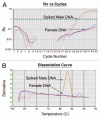Male microchimerism in peripheral blood leukocytes from women with multiple sclerosis
- PMID: 21547029
- PMCID: PMC3084949
- DOI: 10.4161/chim.2.1.15151
Male microchimerism in peripheral blood leukocytes from women with multiple sclerosis
Abstract
Background: Fetal microchimerism (F-MC), the persistence of fetal cells in the mother, is frequently encountered following pregnancy. The high prevalence of F-MC in autoimmune disease prompts consideration of the role for immune tolerance and regulation. This study examines the association between F-MC and multiple sclerosis (MS), an autoimmune disorder, of undetermined etiology.
Results: 21 out of 51 MS-positive subjects (41%) were classified as positive for F-MC; 4 of 22 (18%) of MS-negative sibling controls, were also positive for MC (p = 0.066). Unanticipated F-MC in controls lead to re-evaluation using 30 female singleton cord blood units (CBUs) as a biological control. Four CBUs were low-level positive.
Study design and methods: Seventy-three female subjects were assigned to three groups according to disease status and pregnancy history: (1) MS positive (+) women with a history of one male pregnancy before symptom onset (n = 27); (2) MS negative (-) female siblings of MS(+) women with a history of one male pregnancy (n = 22); and (3) MS(+) women that reported never having been pregnant (n = 24). Ten micrograms of genomic DNA obtained from peripheral blood leukocytes of each subject were analyzed for F-MC using allele-specific real-time PCR targeting the SR-Y sequence on the Y-chromosome. MC classification was dichotomous (positive vs. negative) based on PCR results.
Conclusion: The association between F-MC and MS warrants further study to define this relationship. F-MC in women self-reporting as nulligravid, supports previous findings that a significant proportion of pregnancies go undetected. This lead to re-validation of a Y-chromosome based assay for F-MC detection.
Figures

References
-
- Steinman L, Martin R, Bernard C, Conlon P, Oksenberg JR. Multiple sclerosis: deeper understanding of its pathogenesis reveals new targets for therapy. Annu Rev Neurosci. 2002;25:491–505. - PubMed
-
- Murray TJ. The history of multiple sclerosis: the changing frame of the disease over the centuries. J Neurol Sci. 2009;277:3–8. - PubMed
-
- Chaudhuri A, Behan PO. Multiple sclerosis is not an autoimmune disease. Arch Neurol. 2004;61:1610–1612. - PubMed
-
- Weiner HL. Multiple sclerosis is an inflammatory T-cell-mediated autoimmune disease. Arch Neurol. 2004;61:1613–1615. - PubMed
-
- Racke MK, Lovett-Racke AE, Karandikar NJ. The mechanism of action of glatiramer acetate treatment in multiple sclerosis. Neurology. 2010;74:25–30. - PubMed
Grants and funding
LinkOut - more resources
Full Text Sources
Research Materials
